By Eric Vandenbroeck and co-workers
Occultism And The Celtic Revival
In an earlier
article, we pointed out that while popular with
Irish and Scottish Nationalists that the word "Celtic" slowly came to imply "indigenous", and any
further distinctions were dropped. But there is another underesearched
aspect to early Irish and Scottish Nationalism and that is (as among
others pointed out by Dr. Mark Williams Senior Lecturer in Early Modern
History) its
relationship to the occult. Also in his book about the Celtic
Revival Mark Williams points to occultists like William Butler
Yeats (in his relationship with the Golden Dawn) and George
William Russell and his relationship with Theosophy.1
Early on a member of
the Irish Republican Brotherhood and who served two terms as a Senator of the
Irish Free State W. B. Yeats as we pointed out worked for Irish independence,
but he conceived of it in terms that were primarily
related to his occult studies. And Yeats hoped to gain intimate knowledge
of a sacred or "hidden" Ireland through his occult practices. He saw
the occult practice as a source of reliable information about the connections
between what he used in his literary work and the wellsprings of national and
occult knowledge. In order to claim this secret knowledge, he and several other
students of the occult planned to revive the Druidic mysteries as mentioned, in
a stone castle on Trinity Island. Here Irish republican revolutionary Maud
Gonne, William Sharp (wrote under the name of Fiona Macleod) who took an
interest in the La Jeune Belgique movement where he
saw parallels with Scotland’s situation, the uncle of W.B. Yeats George Pollexfen (who like Yeats was initiated into the Golden
Dawn, Annie Horniman (Yeats persuaded her to go to Dublin to back productions
by the Irish National Theatre Society and later opened the Abbey Theatre),
Dorothea Hunter, and Liberal politician George W. E. Russell, all worked
closely with Yeats to design the Castle's rituals and symbolism.
Yeats also consulted
with the founder of the Golden Dawn, MacGregor
Mathers.
They read scholarship
about Irish myths and described "astral" journeys in which they
penetrated the recesses of a "bidden" Ireland and extracted its
sacred power. As a rite of passage, the labyrinth gave shape to the Castle's
underlying political fantasy: that a devoted cabal of ‘initiates’ could work
secretly to shape Irish imaginative culture using the symbols they drew from
Celtic myths and occult experience. For Yeats, the labyrinth reflected the
imperfect conditions of human knowledge and the lengthy process by which
self-awareness is achieved. As he wrote in Per Amico Silentia
Lunae, the fate of human knowledge is to follow the winding "path of the
serpent" and hope for "sudden lightning" flashes of
illumination.2
Patrick Brantlinger has argued that the late-Victorian enthusiasm
for the occult was at times tied to the late-imperial desire to explore and
dominate new territories and was thus complicit in civilizing ‘missions.
Furthermore, many practitioners of occultism and spiritualism framed their
activities as a fusion of religion and science, not as antithetical to
progress.3 Nevertheless, Brantlinger qualifies that
practical supernaturalism could also resist progressivist narratives as it
could be associated with the past and types of mentalities that were primitive
or infantile.4 Social critic Max Nordau was keen to portray practical
supernaturalism as degenerate by characterizing the mystics and those
interested in the Philosopher‘s Stone, Kabbalah, and the Rosy Cross (like
several associated with the Scots Renaissance) demonstrated below) as opposed
to rational logic and science.5 Spiritualism, mysticism, occultism, and
theosophy were reviving or developing throughout Europe in the period for
numerous reasons, and in many cases, these interests indicated a desire for
unorthodox.
What is striking is
that it is this identity that Sharp used to write the vast majority of his
Celtic writings. In part, this replayed the feminine encoding of Celtic
identity in the nineteenth century that was furthered by Matthew
Arnold, as did John Duncan‘s the Riders of the Sidhe an
iconic image of the Celtic revival, a movement that evoked the ancient cultural
identities of Scotland and Ireland pictured here:
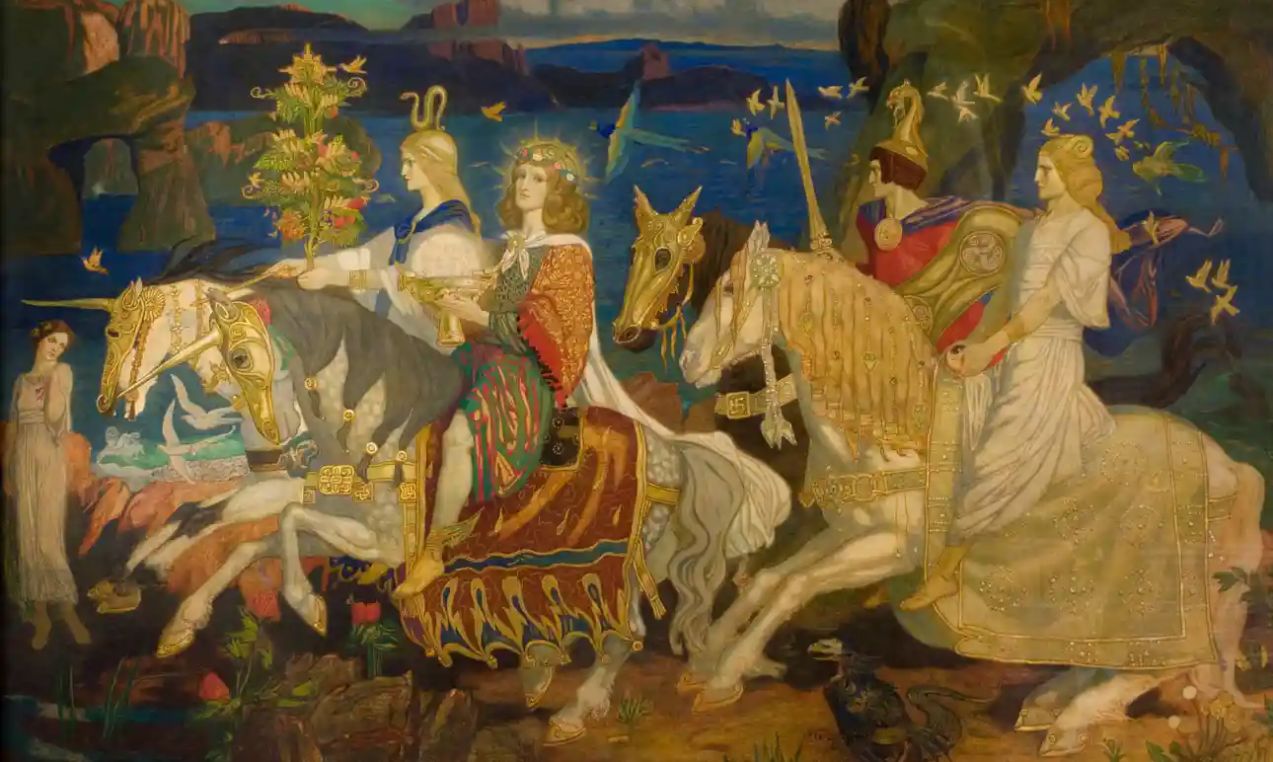
Enter la Jeune Belgique
Among other nations,
Scottish cultural nationalists looked to Belgium to gain inspiration and form a
particular counter-hegemony.
Performing cultural yokings with Belgium and included was also Japan helped the
'other‘ Scotland, distance it from the Metropole, as they were frequently
associated with barbarity and orientalism. The Belgian Revival, in particular,
was a key connection as it provided a close parallel for Scotland to model and
ideas and styles to inspire and strengthen the Scot's Renascence.
The fin-de-siècle
enthusiasm for the Orient and the Belgian Revivalists‘ anti-materiality were
two particularly loathed aspects of Decadent, degenerate culture for those who
held to progressivist narratives. Belgium, in particular, was maligned as
'savage‘ and, like many cultural nationalists in Scotland, Belgian cultural
nationalists embraced the label of 'barbarity‘ as a means of resistance to
authenticate its difference from its larger neighbor (France).
Leela Ghandi has
argued, several affective communities‘ were born at the fin de siècle: those on
the margins within Britain were increasingly looking for solidarity with
sub-cultures elsewhere. In Scotland, this 'politics of friendship‘,6 as Ghandi
terms it, is particularly apparent, in many ways, it fuelled
the Scot's Renascence.7
This discourse of
Decadent barbarity interacted with cultural representations of international
power dynamics. Often, the barbarous‘ were taken to be those who stood against
hegemonic notions of enlightened amelioration and were equated with colonial
subjects, indeed, Decadence was frequently associated with imperial demise, as
it was believed to be challenging progressivist narratives or supporting the
primitive‘ in some way.8 This is revealed in Edward T. Reed‘s Britannia à
la Aubrey Beardsley.
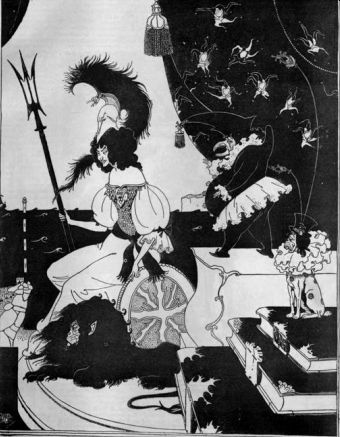
Here, through
mimicking the Decadent style of Aubrey Beardsley, the British
national, imperial figure is represented as grotesque and dark-haired, a
feature which was most commonly associated with Southern European, Catholic
countries. At the same time, fair hair tended to be associated with the
supposedly more civilized‘, evident in E. vom
Baumgarten‘s Civilisation.‘ Furthermore, the Union
flag on Britannia‘s shield is thorny, and various objects take on a subversive
character.
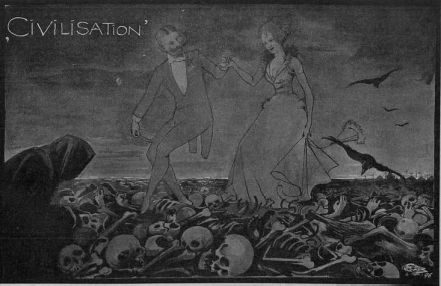
Indeed
even Charles Baudelaire wrote: I far prefer the cult of Teutates to
that of Mammon, and the priest who offers up to the cruel extorter of Human
sacrifice victims who die honorably, victims who take it upon themselves to
die‘.9 Here, Baudelaire asserts his preference for the savage‘ Celtic cult to
the civilized ‘ Christian and his fascination with druidic sacrifice and dying
honorably a central traditional Highland custom. Cultural nationalists in
Scotland were increasingly trying to rekindle an enthusiasm for such Highland
and Celtic cultures, which, as in colonial resistance, involved embracing its
own critique [of barbarity] to assert its authenticity and difference.10 Like
Baudelaire, who found solidarity with the other‘ elsewhere, Scottish cultural
nationalists at the fin de siècle were looking to other cultures for
inspiration and yoking some of their cultural tropes to form a
counter-hegemony, to distance (although not divorce) Scotland from the
metropole. By performing cross-cultural triumph[s] of barbarism‘, Scottish
cultural nationalists were aligning themselves with Decadent attempts to resist
or complicate stadial narratives of improvement. Not only did Belgian and
Japanese cultures have their own ties to Decadence in this period, the general
styling of a politics of friendship‘ to resist narratives of civilization‘ is
consistent with varieties of Decadence.
Like Scottish
cultural nationalists, several Belgian Revivalists were too looking to the past
and less civilized ‘ culture to revive their distinct nationality, which was
increasingly marginalized. Through a cross-cultural association with Belgium,
Scottish cultural nationalists could lend strength to their resistance to European stadialism,
creating a counter-hegemony that could support the triumph of barbarism‘ while
getting inspiration from the Belgians‘ ideas, subjects, and styles.
In the first volume
of the Scottish Chapbook, from August 1922, Hugh MacDiarmid uses Belgium
as a model for how Scotland can develop its own cultural revival. He writes:
What Belgium did, Scotland can do […] Let the exponents of […] Scottish Literature
today make common cause as the young Belgian writers […] did in La Jeune Belgique and elsewhere, and the next decade or two
will see a Scottish Renascence as swift and irresistible as was the Belgian
Revival between 1880 and 1910.11
He sees the above
mentioned William Sharp, the Celtic Revivalist who contributed to (and was
involved in the management of) The Evergreen and Patrick Geddes and Colleagues‘
Celtic Library, as the embodiment of this tendency; Sharp was an exponent of
Old Romance‘ Scotland that suffocated a real Scottish revival of modernity and
internationalism.12 What MacDiarmid overlooks here is that it was Sharp, the
supposed inhibitor of a true Scottish Revival, who pioneered the idea of using
la Jeune Belgique as a model for a Scottish national
revival thirty years previously.
In his rejection of late
nineteenth-century culture, critics often misunderstand that MacDiarmid was not
simply circumventing inherited national inferiority‘, as Scott Lyall
believes.13 Instead, MacDiarmid experienced his own anxiety of influence: he
curtailed his indebtedness to previous work to foreground his own
originality.14 Scottish Literature must address this anxiety of the Modernists.
While other critical cultures have successfully traced the emergence of
Modernism back to the 1890s, Scottish Literature has struggled to; one of the
ways this can be done is by interrogating some of MacDiarmid‘s and his
contemporaries‘ self-aggrandizing claims and tracing their ideas back to the
nineteenth century.
Sharp‘s reputation
had suffered due to critical attention almost entirely focussing
on his Fiona Macleod‘ writings, which MacDiarmid most likely had in
mind when he wrote his article for the Chapbook.
Sharp (what was
almost like a split identity) could be incredibly contradictory: at times,
his writings contribute towards marginalizing the Celt and are defeatist over
the Celtic cause while, at others, they can challenge civilization‘, Yeats, for
one, believed that Fiona held the keys to the gates of the primeval world,
which shut behind more successful races when thy plunged into material
progress.‘15 It is necessary to note a thread of resistance to centralization
and marginalization in Sharp‘s oeuvre, which is revealed in his belief that
London is so overwhelming provincial because it is the center of the provincial
mind gravitates‘.16 Confronting the metropole and civilization ‘ underpins
Sharp‘s enthusiasm for Belgian culture. Through studying Sharp‘s interest in
the Belgian Revival (as well as the Glasgow School‘s), I reveal how Belgian
national culture, which Sharp notes was also labeled as backward‘ in the
period, confirmed by Max Nordau‘s styling of Maeterlinck‘s work as
utterly childish idiotically-incoherent‘ Decadent mysticism,17 was used to
support the Celtic Revival and Scottish cultural nationalism. Furthermore, the
Belgian Revival offered a comparative in which the Celtic Revivalists could
find fellowship and a literary and visual vocabulary to resist Sharp. The
Glasgow School embraced incorporation, the subjects and, styles adopted by
certain Belgian figures to support their efforts. This section will examine how
the two nations were compared in the period and then demonstrate how a cross-cultural
triumph of barbarism was performed by sharing and yoking visual and literary
styles.
Criticism needs to
acknowledge that Sharp played an important role in the UK‘s engagement with the
Belgian Revival, being one of the first main importers of Maeterlinck into the
British Isles. Previously, it has been understood that these writings came into
the UK via Ireland (Katharine Worth argues that it was always a tale of three
cities, Dublin, Paris and London‘18, but this understanding ignores the
importance of Scotland. It also overlooks the Belgian cultural nationalist
movement. Many of the writings of la Jeune Belgique
intended to resist the metropole and complicate civilization-barbarity
discourse, a core reason why several Scots styled a cultural politics of
friendship‘ with it. Sharp prided himself on being the first major critic and
enthusiast of the Belgian Revival. In a letter to Catharine Janvier, he
comments on his article in The Academy, which concerns a subject wherein I am
(I suppose) the only specialist among English men of letters, the Belgian
Literary Renaissance since 1880‘.19 He certainly wasn‘t the first critic:
William Archer, a Scot, wrote the first article in English on Maeterlinck
(1891),20 followed by Hall Caine‘s introduction to Gérard Harry‘s English
Translation of La Princess Maleine and The Intruder
(1892), which Oscar Wilde was originally requested to do.21 However, Sharp‘s
article in The Academy shows a far greater knowledge of the field. He himself
dismisses Archer‘s and Caine‘s pieces, finding them inadequate‘ and questions
their familiarity with the scope of the Belgian Literary Revival.22 It is worth
noting that these four men were all born in Celtic‘ nations: Archer and Sharp
were Scottish, Caine was Manx, and Wilde was Irish. Furthermore, Sharp was
likely introduced to these texts by Edith Rinder, who would become closely
involved in Geddes‘s Celtic Revival project and looked to other cultures for
solidarity. Not only did she produce a collection of Breton Romances and folk
tales for the Celtic Library, The Shadow of Arvor
(1986), she translated several Belgian Revival texts that were compiled and
published as The Massacre of the Innocents: and Other Tales (1895), after
receiving consent from Maeterlinck.23 The Belgian movement was clearly
appealing to those on the fringes.
Sharp‘s desire to
disseminate knowledge about the Revival is reflected in the fact that he wrote
four other essays on the Belgian Revival, reviewed the work associated with it,
and executed several translations. In the second volume of The Evergreen, which
Geddes intended to distribute in Brussels,24 Sharp included his translation of
The Night-Comers‘by Charles van Lerberghe and a note
that gives some basic context for the Belgian Revival. The Glasgow Herald noted
that Sharp was doing good service in opening what is practically a new field
for readers in this country.25 His most important article on Belgium, where he
reveals his cultural nationalism, is A Note on the Belgian Renascence‘ (1895).
Here, Sharp highlights that the Belgian Revival was a means of resisting
cultural centralization towards Paris. He writes:
A group of writers,
all young in heart and mind, if not youthful in point of age, cohered in a
common bond: the bond of a national, independent, original literature. The whip
of Baudelaire, if it had lashed some into servility, had strung others into revolt.
It was not now a question of the Franco-Belgian but of the Belgian. (p.
152).
For Sharp, Young
Belgium‖ is […] concentrated in the effort to withstand Paris‘ and to resist
any political attempt from France or Germany to appropriate their nation.26
Baudelaire‘s critiques of Belgian culture as slavish‘ (p. 150) and parochial
had nurtured scorn for Belgium in France and ignited a new movement in Belgium;
Sharp notes that Belgians were increasingly considered barbarian‘.27 Many of
the works of the movement explicitly reflected this nationalism: Maeterlinck‘s
The Massacre of the Innocents‘ (originally published in Pleïade
in May 1886 and translated by Rinder) is set in a Flemish-speaking Nazareth,
infiltrated by a Spanish army who kill the Flemish-speaking children; it is
clearly concerned with the loss of Flemish culture. In Sharp‘s view, Belgian
cultural nationalists tried to rekindle their distinctively Teutonic side‘ (p.
156). The national divide between the Teutonic and non-Teutonic in Belgium
invites comparisons with Scotland. While the Scots and the Irish were trying to
distance their racial heritage from Teutonism,
Belgian cultural nationalists identified more with it. Despite the racial
disparity, Sharp uses this discussion on Belgium and its relationship to the
metropole to inject feeling into Scottish and Irish nationalism by drawing
comparisons between them. Like Belgium, Sharp notes that Scotland and Ireland
were neighbors with larger powers and felt pressure to incorporate into the
larger culture or face being marginalized. Sharp believes that in the
mid-nineteenth century, Celtic Irish and Celtic Scots obscured rather than
obtruded their Celticism‘ (p. 151), something which
had to change. The essay suggests that he still believes a centralizing force
is evident in the UK in the 1890s; he writes:
As the Londoner
smiles when he hears, the provincial‖ (whether from Edinburgh or Dublin or the
darkest of the lost shires) speak of, society, so the Parisian man of letters
condescended towards any new Belgian poet or novelist‘ (p. 150). Here, Sharp
refers to the London-centric force in the present tense, but the Paris-centric
in the past; while the Belgians had achieved cultural independence, Ireland and
Scotland still had work.
Sharp draws from the
Belgian Revivalists‘ ideas and their theatrical styles, which further yoked
Belgian and Celtic cultures. This is evident in Sharp‘s final major connection
with Maeterlinck and the Belgian Revival: producing one of his own Celtic plays
alongside two Maeterlinck plays in 1900. Sharp was the first Chairman of The
Stage Society in London and, at the fifth meeting, his play The House of Usna (written under the Fiona Macleod pseudonym and
encouraged by Yeats, who wanted Fiona to supply work to the Irish theatrical
revival.28 was performed, followed by two short Maeterlinck plays, The Interior
and The Death of Tintagiles. The production was
directed by Granville-Barker and overseen by Sharp. Although it was not
universally well-received (a reviewer for The Outlook stated that the evening
began in the gloom, continued in dejection and ended in despair‘,29 the content
and style of Usna reflect Sharp‘s interests in
associated cultural nationalisms. The production reveals how Sharp, like the
Glasgow School of artists, used styles and ideas that Belgian Revivalists also
used to help reject exteriority's bondage,30 as Symons named it, an idea
connected to the triumph or barbarism‘ as it further distanced Scottish culture
from civilized‘ materiality.
Sharp was not the
only Celtic Revivalist who identified with la jeune
Belgique. Visual artists, particularly in Glasgow, who Geddes believed headed‘
Scotland‘s Celtic movement,31 were enthusiasts of Maeterlinck‘s works and
brought his styles and ideas to bear on their art. The Glasgow Four and many of
their colleagues around the Glasgow School of Art were closely engaged with
Maeterlinck‘s work. Still, this context has received little critical attention
and has not been considered in light of Scotland‘s growing cultural
nationalism. Like Sharp, drawing from Maeterlinck‘s work supported their
attempts to develop a vocabulary of antimaterialistic
images‘ to combat a period defined by material, utilitarian and scientific
progress, which Mackintosh (like Yeats) believed was compromising traditional
Scottish culture. For many associated with the Glasgow School, the Belgian
connection to countering narratives of improvement helped distinguish and
internationalize Scotland‘s culture.
Several of
Maeterlinck‘s plays were performed in Scotland, between 1900 and 1920. In 1900,
Mrs Patrick Campbell performed in Pelléas and
Mélisande, as Mélisande, at the Theatre Royal in Glasgow, which she reprised in
1905 (in French) alongside Sarah Bernhardt who (at the age of 60) played the
male protagonist, Pelléas, in Edinburgh. A year after the first performance, a
substantial assessment of Maeterlinck appeared in The Edinburgh Review.32
Underneath Sarah Bernhardt and Mrs
Patrick Campbell in the 1904 reprisal of Pelléas and Mélisande:
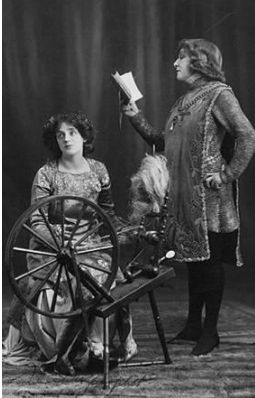
Between 1900 and
1920, there was also a concerted effort to bring Belgian energy to Glasgow‘s
artistic community. Francis Newberry hired Jean Delville,
the noted Belgian Symbolist painter, occultist, and personal friend of
Maeterlinck,33 to be the first head of painting at the Glasgow School of Art in
1900, a position he held until 1906. He also hired Frederick Cayley Robinson,
an important illustrator of Maeterlinck‘s work who designed sets for The Blue
Bird, approved by Maeterlinck, as Professor of Figure Composition between 1914
and 1924. These attempts to bring the Belgian energy to Glasgow certainly had
an impact on the artists there. Jessie M King, one of the leading book
illustrators in Scotland, designed five covers for Maeterlinck‘s plays: Alladine and Palomides (1907),
The Interior (1908), The Seven Princesses (1909), The Death of Tintagiles (1909), and The Intruder, all of which were
published by Gowan‘s and Gray Ltd, in Glasgow. She also drew a scene from
Pelléas and Mélisande included in the special winter number of The Studio
(1900-01). The flattened, elongated designs, disembodied figures, limited color
range, and crisp, often sinuous, lines embody the less realistic and more
symbolic and stylized representation that Yeats and Sharp wanted to pursue
through other art forms; it also reflects the style used in her own Celtic
Revivalist illustrations and jewelry.
This influence also
involved Margaret Macdonald Mackintosh and Charles Rennie Mackintosh,
one of their most important commissions: Fritz Waerndorfer‘s
Music
Room in Vienna. The design is the most explicit expression of Maeterlinckian inspiration in their work and is now often
referred to as the Maeterlinck room‘. Waerndorfer saw
Mackintosh and Macdonald‘s work at the Eighth Secession Exhibition in Vienna
and purchased a silver brooch by Margaret Macdonald, a drawing, and two prints‘
from the Scottish Section.34 Waerndorfer also went to
Glasgow to see the Mackintoshes‘ work, and he commissioned them to design his
music room.35 The result was a scheme called The Seven Princesses, based on
Maeterlinck‘s play of the same title. In the play, Seven Princesses are locked
in a glass room on the stage, sleeping. Prince Marcellus returns by sea to
visit the Princesses and choose a bride, but by the time he manages to break
into the room from below through the family crypt, Ursula, his chosen one, is
dead. Stylistically, the play is akin to The Interior: presenting the audience
with a glass cage, embodying the fourth wall. The haunting voices that recur
throughout further interrogate theatrical illusionism, replacing exteriority
with disembodied mystery. It is this plot and these styles that greatly
influenced the room‘s design.
Margaret Macdonald, [left] Opera of the Winds; [right]
Opera of the Seas, gesso panel, 1903
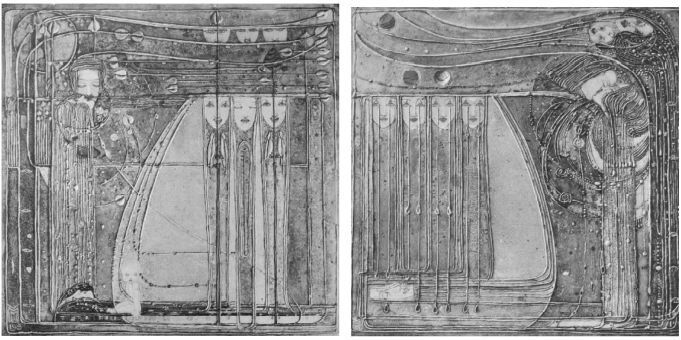
The subjects and
styles of the Belgian movement offered the Scots a vocabulary of barbarity and
resistance to materiality that informed their developments and allowed an
associated cultural movement to develop. In doing this, they (perhaps
unconsciously) contributed towards the development of a counter-hegemony. When
considered in the context of Sharp‘s writings, their work reflects the desire
to bring like-minded cultures together to subvert stadialist
and utilitarian narratives that sought to malign cultures on the margins
seeking to preserve or recover themselves.
Enter Patrick Geddes and the Scottish
Nationalist Evergreen Club
Although previous
biographers have mentioned that Geddes was familiar with Annie Besant, who
headed the Theosophical Society, and Geddes’s close collaborator the artist
John Duncan himself became a Theosophist in 1909 or Geddes links
with Hindu revivalists, Swami Vivekananda, Ananda Coomaraswamy, and
Rabindranath Tagore and where his ‘Inlook’ Tower
was described as a place for meditation while leaving out the seership aspect
we will, by using credible sources, go much further than that.
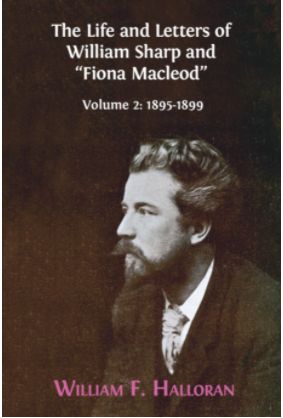
Luke Barnesmoore from the Center for Critical Interdisciplinary
Studies who referred to "The
Two Images of Sir. Patrick Geddes, Liberal and Mystic." Writes that
though Patrick Geddes’ (1854-1932) has often been derided by Modernists as
‘a jack of all trades, and master of none’, as a poor writer, as an eccentric
romantic whose own subjective desires led him into the seemingly (from the Modernist
Worldview) impossible project of reconciling science and spirituality, etc.,
Geddes was a pure reflection of the ideal set forth by the Neoplatonic
tradition in an era where science’s capacity to plumb the secrets of the
manifest world was expanding exponentially.
And
although Geddes’ does not appear to have had any commitment to the
House of Stuarts, his edition of "The Evergreen"
magazine included several references to Jacobite symbolism. Whereby in
this case it was the Golden Dawn a key for expressing this neo-Jacobite
identity and an ancestral Scottish past.
Co-founder of the Hermetic Order of the Golden Dawn, Samuel
Liddell MacGregor Mathers (who added the "MacGregor" surname as a
claim to Highland Scottish heritage) imagined himself as a defender of Scottish
cultural and political identity: Yeats stated that Mathers imagined a
Napoleonic role for himself, a Europe transformed to his fancy, Scotland a
principality, Egypt restored‘.36 Mathers also sought to re-establish the Celtic
pantheon (like Yeats), which was partly the purpose behind his planned magazine
Isis,37 which suggests that the ancient esoterica of the Celts and the
Egyptians were interdependent for Mathers. This detail further supports the
reading that the numerous Egyptian references in The Evergreen were not simply
accidental and were connected to the Scots Renaissance. Mathers‘s ideas were
not far removed from Brodie-Innes‘s, the Imperator of Amen-Ra, who was close to
Mathers and whose writings fit into the wider trend of fin-de-siècle cultural
nationalism. Not only was Brodie-Innes‘s father a member of the New Spalding
Club, which published Historic Papers on the Jacobite Period in 1895, but
Ithell Colquohoun has stated that he may have been a
member of the White Rose Society, a neo-Jacobite club.38 Brodie-Innes‘s
writings reveal that he was concerned with recovering the Celtic identity from
complete incorporation; he wrote in 1917:
Altogether the foot
of the Saxon has been hefty on the west, and the old occultism and the old
fairy lore have retreated out of sight, and largely I fear out of mind [...] I
have tried to string together a few rambling memories [...] I can only vouch
for their truth as personal experiences of a time when the occultism of the
Celtic west was not only a genuine thing but was looked on as utterly
natural.39
It is important to
note here that Brodie-Innes believed that identity might exist even if it could
not be seen and that he styles his work as concerned with preserving the
marginal. Brodie-Innes also worked to maintain the independence of the Scottish
Lodge of the Theosophical Society, according to R. A. Gilbert.40 Both Mathers
and Brodie-Innes clearly had an interest in defying the incorporation of
Scottish and Celtic identity.
This fact may even have
informed the Golden Dawn as it is known that members became disgruntled over
how the Golden Dawn was becoming defined by Mathers‘s and Brodie-Innes‘s ideas.
Annie Horniman, who was expelled from the Golden Dawn for not continuing to
give Mathers money because he was using it for political over magical
purposes,41 noted on this topic that Mr. Brodie Innes boasted to me that he was
in continual correspondence on political matters with Mr. Mathers not on Order
business‘.42 Perhaps their shared interest in reviving the Celtic pantheon and
neo-Jacobitism started to define the Golden Dawn. The Golden Dawn may not only
have provided the structure to express a disruptive, older Scottish self but
there may even have been attempts to mobilize these temples in the name of
cultural nationalism or Celtic Revivalism. Beyond these ties to Scottish
cultural nationalism, the most direct connection between the Golden Dawn and
Scots Renascence was The Evergreen Club‘.
In The Scots
Renascence‘, the importance of the occult and practical supernaturalism to
Geddes‘s ideas on the revival of Scottish cultural identity is revealed. Here,
he describes Edinburgh as an ice-pack of frozen culture‘, in a manner that
anticipates Muir‘s Scotland‘s Winter‘, Scottish culture has suffered a period
of apparent death or dormancy. Towards the end of the essay, he evokes the
nature of the nascent revival when he describes watching over the tombs of
national heroes:
And so in some young
soul here and there, the spirit of the hero and the poet may awaken and press
him onward into a life which can face defeat in turn. Such is our Scottish, our
Celtic Renaissance, sadly set betwixt the Keening, the watching over our fathers
died, and the second-sight of shroud rising about each other. Yet this is the
Resurrection and the Life, when to faithful love and memory their dead arise.43
To revive an
unacknowledged cultural identity is compared to contacting the dead. Geddes
uses the language of exoteric spiritualism and second-sight to suggest that
recovering Scotland‘s national cultural identity requires both the ability to
see what is not recognized and the desire to revive (through collective memory)
what is gone.
Here, he expresses
his belief in celebrating Celtic archaic survival[s]‘ and his faith in the
indestructible sovereignty of the ever-returning past‘ which can challenge stadialism and stimulate a sense of continuity and
connection.44 The importance of continuity to the Scot's Renascence is also
evident in Geddes‘s use of the expression Ultimus Scotorum‘
in the essay to describe Blackie and Stevenson, as it indicates his belief that
a stronger, ancestral identity has been preserved. His essay argues that these
continuing flames need to be fanned.
William Sharp
similarly shared the importance of recognizing the continuing but hidden
collective self through concepts associated with practical supernaturalism.
When writing to Catharine Janvier, he stated: „A deep current somewhere beneath
the tide […] sustains us. We have meeting places that none knows of; we
understand what few can understand and share a strange and inexplicable
heritage in common.45 Like Geddes, Sharp, who was fascinated by the occult,46
believed that Celtic Revivalism would involve contacting the lost or hidden
past; he even believed he could channel Colum‘s spirit and portrayed his Fiona
writings as a form of mediumistic contact with a Celtic identity.47
For Sharp, the Anima Celtica, represented by John Duncan, was in a spell-bound
trance‘, another representation of the Celt as not dead but dormant, belonging
to the occult sphere, and waiting for a blast‘ to be roused.48 These notions of
a past identity that was hidden and depended on the occult sphere and
spiritualist contact for expression were not simply rhetorical ideas for Sharp
and Geddes: Geddes planned society for the contributors to The Evergreen that
had many ties to the Golden Dawn and bears marked connections to Yeats‘s Order
of Celtic Mysteries, also derived from the Golden Dawn. It strongly appears as
though this occult-inspired club intended to provide a space to express an
ancestral, hidden self: to
give people their identification paper‘, as Frantz Fanon called it.
The Evergreen Club‘
was the product of a culture in Edinburgh that was captivated by esoteric
occultism and supernaturalism. Geddes was deeply interested in the history of
witchcraft in Scotland and frequently associated his Celtic Revivalism with
practical supernaturalism. He wrote a collection of note cards on witchcraft
which included references to Celtic witchery‘ and interestingly Fiona,
‘associating Celtic culture with practical supernaturalism.49
But the esoteric had
other, more particular, roles to play in the Scot's Renascence. Practical
supernaturalism was a tool that Geddes believed could help people imagine
society anew, an idea that fed into his civic and national regeneration
projects. The Outlook Tower, which was considered a cultural nationalist
center, was also imagined as a Temple of Vision‘,50 as John Kelman states,
intending to produce trained seers‘.51 Geddes wanted these seers to reveal the
hiddenness of the obvious‘,52 to reject the norm and create mentalities where
new activities may develop. Upon a higher plane than customary ones‘: with
Geddes, the occult provided a framework for expressing counter-cultural
ideas.53 Like several public buildings in the late nineteenth century, including
Alois Bastl‘s planned scheme for a palace for
Scientific Occult Societies‘ (1902) in Paris, The Outlook Tower (and Geddes‘s
comments on it) reflects the need for a quasi-religious space to fill the
spiritual vacuum‘.54 As Nietzsche stated: The time is past when the Church
possessed the monopoly of reflection‘:55 new forms
of public space were required for self and collective reflection. Geddes
referred to the Outlook Tower in these quasi-religious, quasi-occult terms,
claiming: we have a temple, but what of the Mysteries? What of the
initiation?‘.56 He also referred to his Camera as a wizard‘s mirror‘.57
Geddes‘s enthusiasm for alternative spiritual ideas is reflected in his
interest in the Bahá‘ì faith (an interest shared with
John Duncan and his wife, who was a friend of Wellesley
Tudor-Pole and his mysticism;58 Tudor-Pole was involved with the Celtic revival and claimed
to have found the H. Grail, whereby Boardman
describes him as a skeptical Western scientist and an Indian mystic‘.59 Geddes
clearly wanted the Outlook Tower to become more of an occult temple than it was
and hoped it would produce seers‘. In his paper What is the Mystic Life‘, he
outlines that he wanted to encourage a mystic life that can calm the ordinary
life and subdue it‘.60 Part of Geddes‘s regeneration and cultural nationalist
projects involved creating alternative spaces to imagine the world anew and
develop different ideas.
One of these spaces
was a planned society for contributors to The Evergreen, which heavily drew
from the language of the Golden Dawn and was at least partly designed to
provide a space for a Celtic counter-culture and to express an ancestral self,
with strong similarities to Yeats‘s Order of Celtic Mysteries. Geddes‘s
involvement with the Golden Dawn is obscure. As yet, no textual evidence has
been found to suggest that he was a member of the Golden Dawn; however,
Alexander Farquharson, who was Secretary of Le Play House, the hub of Geddes‘s
and Branford‘s social betterment movement, claimed that Geddes was connected
with the GD [Golden Dawn] in some way‘.61 It is possible that Geddes
could have been a member of the Golden Dawn as the address books which contain
lists of the initiates are far from authoritative. However, even if Geddes was
not an initiate of the Golden Dawn, it is undeniable that he was aware of it
and shared many of the ideas espoused by the Order. For example, he made notes
from Maeterlinck‘s study of mysticism 62, and Arthur Edward Waite‘s The
Mysteries of Magic: a Digest of the Writings of Eliphas Levi. Waite was a
member of the Golden Dawn, and this book covers various topics on occultism and
specific concepts which the Golden Dawn adopted, including Kabbalistic
doctrines, conjuration, the astral body and tarot, and Geddes makes specific
reference to the second part of the book: Doctrines of Occult Force‘.63 Geddes
is also known to have read Edouard Schuré‘s The Great
Initiates 64, and he wanted to bring more of the ideas it espoused into his own
system. Thus, he was clear that he was interested in and aware of the practices
and ideas on which the Golden Dawn was founded.
Furthermore, it can
be demonstrated that he actively sought to encourage awareness about these
ideas through the Outlook Tower. To prove this, both his work for The Evergreen
and some of his rough notes in the Papers of Patrick Geddes archive need to be consulted
together.
The Evergreen
Club was not just similar in structure to the Golden Dawn but was also closely
bound up with its ideas and practice. Some of the words Geddes uses in his
cards reveal this when considered together; they include Arbor Vitae‘, Rose Croise, ‘Thelema, ‘Chapel, PG, ‘robes‘ and wreaths. ‘ Each
of these will be considered to demonstrate the ties between the Evergreen Club
and occult orders.
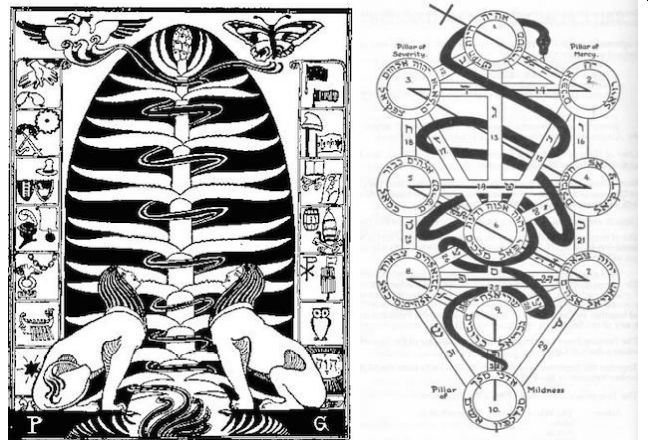
[Left] Arbor
Saeculorum, illustration in The Evergreen, 1895, [Right] The Serpent on the
Tree of Life’ 65
The Arbor Vitae‘, or
tree of life, was a central concept in the Golden Dawn, drawn from Kabbalah.
Geddes‘s interest in the tree of life is reflected in his final contribution to
the Spring edition of The Evergreen, which presents a tree of life, the Arbor
Saeculorum (Figure 4.13). Geddes‘s tree (guarded by sphinxes) does not present
a personal, spiritual development through ten sephiroth from Malkuth (earth) to Kether (invisible sublimity) as in
Kabbalah but presents the development of society stemming from roots in the
animal world and flourishing with a bud at the top. However, this in itself is
highly reminiscent of the ascension and crown at the top of many Kabbalistic
trees. The serpent-like smoke which links all of the various stages together in
Geddes‘s design also echoes several representations of the tree of life in
Kabbalistic iconography (Figure 4.14) and what Mathers refers to as the serpent
of wisdom‘,66 a centripetal force, ever seeking to penetrate Paradise‘,67 or,
as Yeats says, the Kabbalistic serpent-winding nature‘.68 This feature may have
ties to Mackintosh‘s designs, with ascending helical spirals, drawing from
Kabbalistic iconography. As was discussed in Chapter 3, Geddes‘s Arbor also
partly challenges the notion of Enlightenment radicalism as he believed that
each of these stages was intertwined with each other and the smoke represents
the blindness of each generation to the thought and work of their ancestors The
Rose Croise‘, or Rosy Cross, is an apparent reference
to the symbol of the Rosicrucian Order, believed to have been established by
the legendary alchemist Christian Rosenkreuz around the fifteenth century,
consisting of a cross with a rose in the center. Rosicrucianism, which fused
Eastern philosophy with traditional Christian beliefs and claimed to harbor
esoteric secrets‘,69 was reviving across Europe in the period, most notably
with Joséphin Péladan, who
was a member of the Ordre de la Rose-Croix before going on in 1891 to found his
own Catholic version, the Ordre de la Rose-Croix Catholique‘
which sought to revive traditionalism and was nostalgic for the ancien régime.70 Using his occult order as a backdrop Péladan went on to organize exhibitions of Symbolist
artists and associated French avant-garde painters, writers, and musicians, as
the Salon de la Rose + Croix:
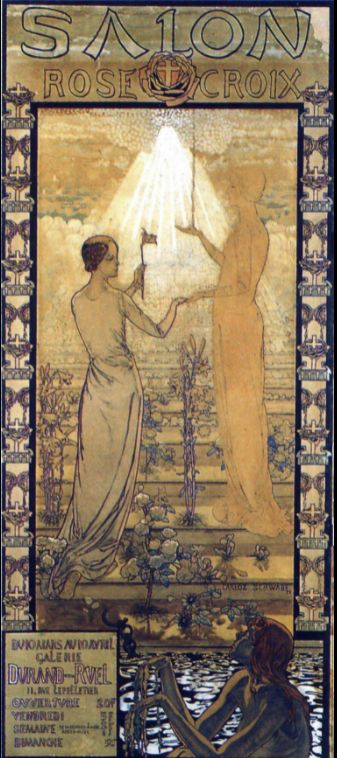
For Nordau,
Rosicrucianism was one of the features that marked Péladan
as degenerate, or deranged‘.71 By the 1890s,
Rosicrucianism‘s bond to Protestantism had loosened (indeed, Waite notes that
Catholic initiation was accepted as early as 1710).72 It became the origin of
the Order of the Golden Dawn. There was also a strong tradition of
Rosicrucianism in Scotland, which Geddes may be alluding to here. David
Stevenson has demonstrated that modern Freemasonry, and lodges with ritual
functions, originated in Scotland in the seventeenth century from town craft
guilds. These were implicated in the development of Rosicrucianism from 1598.73
The Rosicrucian quest for ultimate secrets‘ (p. 104) led many interested in
Scotland to the Masonic Lodges claimed possession of arcane secrets‘ (p. 104).
Stevenson also shows a detailed knowledge of Rosicrucianism throughout
Scotland, too (p. 101). Geddes‘s interest reflects the continuance of
Rosicrucian ideas in Scotland and a desire to develop a counter-culture
interested in arcane secrets‘.74
Geddes‘s reference to
Thelema is striking and complex, especially considering we do not know when
these cards were written. It is logical to assume that they were written when
Geddes was working on The Evergreen, thus 1895-6. However, Thelema only became
an idea particularly associated with occult orders in 1901, through Aleister
Crowley (a key initiate of the Golden Dawn), who established a magical system
entitled Thelema and named Boleskine House, which he
bought off Mary Rose Hill Burton (a friend of Geddes‘s that contributed
decorative panels to Ramsay Gardens), his Abbey of Thelema.75 This system‘s
philosophy was to do what thou wilt, then do nothing else.76 Crowley, like
Geddes, was clearly drawing upon Rabelais who wrote of an Abbey of Thélème in Gargantua and Pantagruel, where do what thou
wilt‘ was the philosophy. Strikingly, Boardman notes that Geddes established an
Abbey de Thélème‘ in the Mediterranean, to be used
for excursions from Scots College in Montpellier, to improve university life
and further his Agenda Synthetica.’77
Although Geddes is
not generally associated with hedonism, we can see hints of the Thelema
attitude in his thinking, such as started stated to his daughter Norah: I am
still out for adventure, for all risks; and [do] not need Nietzsche to teach me
to live dangerously‘.78 In this case, it appears that Geddes‘s conflation of
Thelema with Rosicrucianism and Kabbalah antedates Crowley‘s similar intention
and could be further proof that Geddes may have had greater ties and influence
on the Golden Dawn than previously believed.
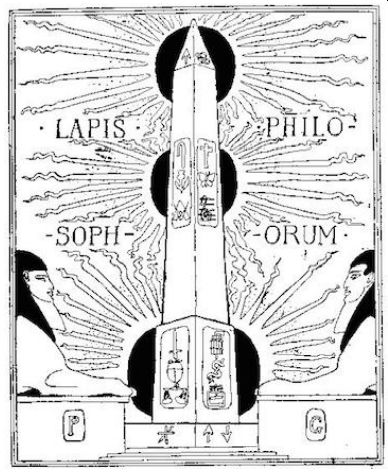
Lapis Philosophorum,
illustration in The Evergreen, 1896
The apparent cultural
nationalism of the club is confirmed by one of the decorations for The
Evergreen. Beyond his inclusion of the Arbor Saeculorum, Geddes also
contributes Lapis Philosophorum to the final page of
the final issue of The Evergreen (Figure 4.16). The concept of the
Philosopher‘s Stone, and its associated idea of transmutation, was important in
Golden Dawn magic, and it was key for Geddes:79 he believed it was scattered
through the world‘,80. He conflated it with the Elixir Vitae.81 The essentially
hieroglyphic symbols […] by the initiated for the initiated‘ in Geddes‘s Lapis Philosophorum also suggest links to the occult,82 the
sphinxes, obelisk and bursts of sun rays provide obvious connections but the
scarab beetle, the Masonic square and compass (albeit upside down) and the
alchemical symbol of the Rod of Asclepius all nod to esoterica. The arrows
pointing both upwards and downwards suggest, like Arbor Saeculorum, that
historical progression cannot be disconnected from its past. In the Papers of
Patrick Geddes, there is a key to these symbols. The hieroglyphs are arranged
to represent how a more primitive existence can generate community and lead to
Eutopia‘. Importantly, Geddes includes a thistle on the obelisk in The
Evergreen, representing Scottish nationality, alongside other symbols that he
states represent comradeship‘ and communion.’83 This indicates the importance
of collectivism and nationhood for Geddes and his interest in portraying
Scottish identity and the occult as interdependent. Together, this image
expresses the need to recover the ancestral and define the national community,
which is bound up with the occult, much like his planned club.
The Evergreen and its
society reveal Geddes‘s desire to associate Scotland closely with the occult
and to draw from its symbolism and structures to create a space for a
collective voice. As with Yeats‘s Order in Ireland, there strongly appears to
be a desire to use occult images and societies to express Scottish identity.
This language of the occult is also used in the decorative work for the Celtic
Library. The Gold inlay designs for the front and back cover of The Washer of
the Ford borrow from many occult forms. Most notably, the image on the front
cover, which consists of two thistles (Figure see below), stresses upward
ascension. The interlinking nature of the forms in the middle column is not
unlike those of the Kabbalistic tree. These forms also resemble interlinking
compasses, which are symbols common to Freemasonic orders. The image of
concentric circles, triangles, hidden thistles, and a bursting sun on the back
cover (Figure see below) is also similar to many features of the Golden Dawn,
most notably the sun (literally golden dawn) and the triangle, which reflect
the imagery of the Amen-Ra temple and the Golden Dawn more widely. Again, the
designs here are concerned with suggesting the affinity of Scotland and the
Celtic Revival with secret societies and the occult.
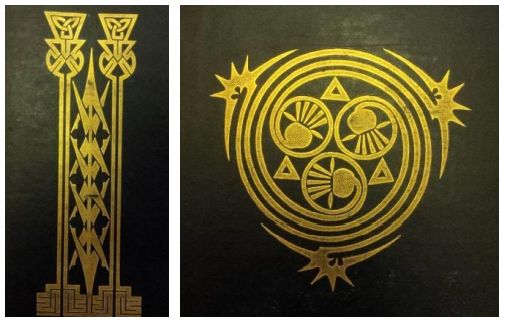
Front [left] and back [right] cover designs, The
Washer of the Ford, 1896
Scottish cultural nationalists
were interested in practical supernaturalism, and they appear to have been so
for three main interrelated reasons. Associating the national identity with
practical supernaturalism helped confirm the nation as other‘, unaccommodating
to stadialist notions of improvement. Egyptian
esoterica, associated with various forms of fin-de-siècle practical
supernaturalism, offered the ability to link Scotland to Egyptian culture and
helped articulate or support a further myth of descent. Most particularly, the
occult-inspired means of expressing and preserving an ancestral Scottish self,
of contacting and recovering periods of healthier nationality. In these
respects, supposedly degenerate occult orders and exoteric ideas supported
Scottish cultural nationalism and the notion of national descent.
Also in the Scottish
National Exhibition Pageant was performed as part of the National Exhibition at
Saughton Park, Edinburgh, in 1908, which presented
Scotland‘s history in pageant form. These were organized and designed by John
Duncan, Jessie M King, and Phoebe Traquair,
respectively.
Whereby Duncan and
King performed in the pageant: Duncan as Cormac and King as the Angel of the
Holy Graal, as seen pictured here:
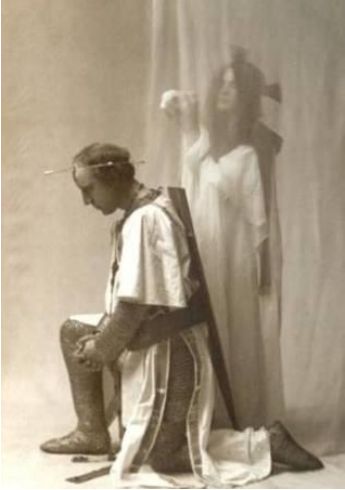
The Angel of the Graal and Sir Galahad, National
Exhibition Pageant, 1908
1. Mark Williams,
Ireland's Immortals: A History of the Gods of Irish Myth, 2016, p. 313 ff.
2. W.B. Yeats, Per
Amico Silentia Lunae, 1918, p. 39.
3. For Péladan‘s interest in fusing science and religion, see
Maria E. Di Pasquale, Joséphin Péladan:
Occultism, Catholicism, and Science in the Fin de Siècle‘, RACAR 34.1 (2009),
53-61 (p. 53).
4. Patrick Brantlinger, Rule of Darkness: British Literature and
Imperialism, 1830-1914 (Ithaca: Cornell University Press, 1988), pp.
238-240.
5. Max Nordau,
Degeneration (New York: D. Appleton & Company, 1895), pp. 14, 21-22, 220.
6. Leela Ghandi,
Affective Communities: Anticolonial Thought, Fin de Siecle
Radicalism and the Politics of Friendship (Durham, North Carolina: Duke
University Press, 2006), p. 9.
7. For a discussion
on Scottish and Irish affective communities (or fratriotism‘)
over the long eighteenth century, see Murray Pittock, Scottish and Irish
Romanticism (Oxford: Oxford University Press, 2008), pp. 235-258.
8. For more on
Decadence and empire, see Norman Vance, Decadence and the subversion of
empire‘, in Roman Presences: Receptions of Rome in European Culture, 1789-1945,
ed. by Catharine Edwards (Cambridge: Cambridge University Press, 1999), pp.
110-124.
9. Charles
Baudelaire, The Painter of Modern Life and Other Essays, trans. and ed. by
Jonathan Mayne (London: Phaidon, 1995), p. 100.
10.
Murray Pittock, Scottish and Irish Romanticism, 2008, Murray Pittock, p.
26.
11. (cited in) Dr.
Margery Palmer McCulloch, Scottish Modernism and Its Contexts 1918-1959:
Literature, National Identity and Cultural Exchange, 2009,p. 16.
12. Ibid.
13. Scott Lyall, Hugh
MacDiarmid’s Poetry and Politics of Place: Imagining a Scottish Republic
(Edinburgh: University of Edinburgh Press, 2006), p. 31.
14. For a detailed
examination of the various ways writers attempted to appease the anxiety of
influence, see Harold Bloom, The Anxiety of Influence: A Theory of Poetry
(Oxford: Oxford University Press, 1997).
15. (cited in) Willy
Maley, Away with the Faeries (or, It‘s Grimm up North): Yeats and Scotland‘,
Journal of Irish Scottish Studies, 1.1 (2007), 161-178 (p. 170).
16. William Sharp,
The Irish Muse, I‘, The North American Review, 179 (1904), 685-697 (p. 697).
17. Max Nordau,
Degeneration (New York: D. Appleton and Company, 1897), p. 227.
18. Katharine Worth,
The Irish Drama of Europe: from Yeats to Beckett (London: The Athlone Press,
1978), p. 10.
19. Letter from
William Sharp to Catharine Janvier, 12 August 1893, The William Sharp “Fiona
Macleod” Archive, [accessed 18 November 2014].
20. William Archer, A
Pessimist Playwright‘, Fortnightly Review, 50.297 (1891), 346-354.
21. Katharine Worth,
Oscar Wilde (Houndmills: Macmillan Education, 1983),
p. 54.
22. William Sharp,
The Princess Maleine and The Intruder‘, The Academy,
1037 (1892), 270-272.
23. William Sharp, A
Note on the Belgian Renascence‘, The Chap-Book, 4 (1895), 149-157 (p. 153)
[future references to this volume are given in brackets after quotations].
24. Rough notes by
Patrick Geddes relating to The Evergreen, c.1895-1896 [Archives and Special
Collections, University of Strathclyde: T-GED 8/1/3].
25. Miscellaneous
Books‘, Glasgow Herald, 15 November 1895, p. 4.
26. William
Sharp, La Jeune Belgique‘, The Nineteenth Century, 34
(September 1893), 416-436 (p. 418); the desire to withstand‘ Paris is akin to
Geddes‘s attempt to withstand the tremendous centralizing power of the
metropolis of London‘, see Elizabeth A. Sharp, William Sharp (Fiona Macleod)
(London: William Heinemann, 1910), p. 249.
27. Sharp, La Jeune‘, p. 416.
28. Richard Ellman,
Yeats: The Man and the Masks (London: Penguin, 1988), p. 132.
29. Music and
Maeterlinck‘, The Outlook, 5 (May 1900), 434.
30. Arthur Symons,
The Symbolist Movement in Literature, ed. by Matthew Creasy (Manchester:
Carcanet, 2014), p. 8. 77 William Sharp, The House of Usna
(Portland: Thomas B Mosher, 1903), p. 3.
31. Notes by Patrick
Geddes for a lecture to the Celtic Society, 1897 [Archives and Special
Collections, University of Strathclyde: T-GED 5/2/9].
32. M. Maurice
Maeterlinck, Moralist and Artist‘, The Edinburgh Review, 396 (1901), 350-377.
33. Timothy
Neat, Part Seen, Part Imagined: Meaning and Symbolism in the Work of Charles
Rennie Mackintosh and Margaret Macdonald (Edinburgh: Canongate, 1994), p. 122.
34. Peter Vergo,
The Vanished Frieze‘, in A Thoroughly Modern Afternoon: Margaret Macdonald
Mackintosh and the Salon Waerndorfer in Vienna, ed.
by Hanna Egger and others (Vienna: Böhlau Verlag,
2000), pp. 18-40 (p. 28).
35. Janice Helland,
The Studios of Frances and Margaret Macdonald (Manchester: Manchester
University Press, 1996), p. 155.
36. (cited in) Ithell
Colquhoun, Sword of Wisdom: MacGregor Mathers and the Golden Dawn (New York: G.
P. Putnam‘s Sons, 1975), p. 93.
37. Ibid., p.
88.
38. Ibid.
39. J. W.
Brodie-Innes, Some Celtic Memories‘, in The Sorcerer and his Apprentice:
Unknown Hermetic Writings of S.L. MacGregor Mathers and J. W. Brodie-Innes, ed.
by R. A. Gilbert (Wellingborough: The Aquarian Press, 1983), pp. 101-114
(pp. 101-2).
40. R. A. Gilbert,
Introduction‘, in The Sorcerer and His Apprentice: Unknown Hermetic Writings of
S. L. MacGregor Mathers and J. W. Brodie-Innes, ed. by R. A. Gilbert
(Wellingborough: The Aquarian Press, 1983), pp. 7-12 (p. 10).
41. Letter from Annie
Horniman to William Peck on expulsion, 25 December 1896 [The Library and Museum
of Freemasonry: GBR 1991 GD 2/4/1/12].
42. Ibid.
43. Patrick
Geddes, The Scots Renascence‘, The Evergreen, 1 (1895), p. 139 (pp.
137-138).
44. Ibid., p. 138;
Notes by Patrick Geddes for a lecture to the Celtic Society, 1897 [Archives and
Special Collections, University of Strathclyde: T-GED 5/2/9].
45. William Sharp,
The Washer of the Ford: And other Legendary Moralities (Edinburgh: Patrick
Geddes and Colleagues, 1896), p. 3.
46. Sharp‘s interest
in the occult has been researched by many; see William F. Halloran, W. B.
Yeats, William Sharp and Fiona Macleod: A Celtic Drama, 1897‘, Yeats
Annual, 14 (2001), 159-208 (pp. 159-166); A. Norman Jeffares, W. B. Yeats, Man
and Poet (New York: Barnes & Noble, 1966), pp. 107-109;
Steve Blamires, The Little Book of the Great Enchantment (Arcata: R J
Stewart Books, 2008), pp. 125, 154-158, 183-184; Thomas Hodd, The Celtic
Twilight in Canada: William Sharp‘s Early Occult Influence on Charles G. D.
Roberts and Bliss Carman‘, Canadian Poetry, 54 (2004), 37-55 (p. 39).
47. Letter from
William Sharp to Dr. John Goodchild, mid-May 1898, The William Sharp “Fiona
Macleod” Archive Ernest Rhys, Everyman Remembers‘ (New York: Cosmopolitan Book
Corporation, 1931), pp. 79-80.
48. William Sharp,
Introduction‘, in Lyra Celtica: An Anthology of
Representative Celtic Poetry, ed. by Elizabeth A. Sharp (Edinburgh: Patrick
Geddes and Colleagues, 1896), pp. xix-li (p. xliii).
49. Card notes on
Witchcraft, 1905 [Archives and Special Collections, University of Strathclyde:
T-GED 11/1/22].
50. John Kelman, The
Interpreter’s House: The Ideals embodied in the Outlook Tower (Edinburgh and
London: Oliphant, Anderson and Ferrier, 1905), p. 5.
51. Ibid., p.
6.
52. Ibid., p.
15.
53. Patrick Geddes,
‘What is the Mystic Life’, p. 2 [Archives and Special Collections, University
of Strathclyde: T-GED 11/1/93].
54. Iain Boyd Whyte,
The Spirit of the City‘, in The City after Patrick Geddes, ed. by Volker M.
Welter and James Lawson (Oxford: Peter Lang, 2000), pp. 15-32 (p. 16).
55. (cited in) Ibid.,
p. 17.
56. (cited in) Philip
Boardman, The Worlds of Patrick Geddes: Biologist, Town Planner, Re-educator,
Peace[1]warrior (London: Routledge & Kegan Paul, 1978), p. 194.
57. [T-GED 11/1/22].
58. Murdo Macdonald,
Scottish Art (London: Thames & Hudson, 2000), p. 154; Boardman, p. 452.
59. Boardman, p.
452.
60. Geddes, What
is the Mystic Life‘, p. 3 [T-GED 11/1/93].
61. Colquhoun, Sword
of Wisdom, p. 89.
62. Boardman, pp.
450-451.
63. Notes by Patrick
Geddes on the theory of magic as religious awakening, c.1897 [Archives and
Special Collections, University of Strathclyde: T-GED 11/1/13].
64. Boardman, p. 194.
65. This illustration
appears in Israel Regardie, The Golden Dawn (St.
Paul: Llewellyn Publications, 1986), p. 62.
66. S. L. MacGregor
Mathers, Concerning the Symbolism of Self-Sacrifice‘, in Astral Projection,
Ritual Magic and Alchemy, ed. by Francis King (Wellingborough: The Aquarian
Press, 1971), pp. 131-140 (p. 131).
67. S. L. MacGregor
Mathers, The Kabbalah Unveiled, 2017, p. 42.
68. (cited in) Norman
Jeffares, W. B. Yeats, Man and Poet (New York: Barnes & Noble,
1966), p. 107.
69. Di Pasquale,
Maria E., Joséphin Péladan:
Occultism, Catholicism, and Science in the Fin de Siècle‘, RACAR 34.1 (2009),
p. 56.
70. Radolphe Rapetti, Symbolism, trans. by Deke Dusinberre (New York: Éditions Flammarion, 2005), pp.
88-89.
71. Nordau, p. 225.
72. Arthur Edward
Waite, The Rosicrucian Brotherhood‘, The Gentleman’s Magazine, 263 (1884),
598-607 (604); for Freemasonry‘s links to Jacobitism, see Pittock, Material
Culture, pp. 108-112.
73. David Stevenson,
The Origins of Freemasonry: Scotland’s Century, 1590-1710 (Cambridge: Cambridge
University Press, 1988), p. 96 [future references to this edition are given in
brackets after quotations].
74. Timothy Neat
argues that the Glasgow School was also influenced by Rosicrucianism; see Neat,
Part Seen, Part Imagined: Meaning and Symbolism in the Work of Charles Rennie
Mackintosh and Margaret Macdonald (Edinburgh: Canongate, 1994, pp. 120-132. Part
Seen, Part Imagined: Meaning and Symbolism in the Work of Charles Rennie
Mackintosh and Margaret Macdonald (Edinburgh: Canongate, 1994.)
75. Tobias Churton,
Aleister Crowley: The Biography (London: Watkins Publishing, 2011), p. 253;
Geddes also visited Boleskine in 1895 to write on Celtic crosses.
76. Aleister Crowely, The Message of the Master Therion‘, The
International, 12 (1918), 26.
77. Boardman,
p. 451
78. (cited
in) Walter Stephen, Patrick Geddes, the Life‘, in Think Local, Act Global: The
Life and Legacy of Patrick Geddes, ed. by Walter Stephen (Edinburgh: Luath Press, 2011), pp. 17-38 (p. 37).
79. Wynn Westcott,
Alchemy‘, in Astral Projection, Ritual Magic and Alchemy, ed. by Francis
King (Wellingborough: The Aquarian Press, 1971), pp. 179-191.
80. Notes by Patrick
Geddes on the association of ideas, alchemy, psychology, society and
education [Archives and Special Collections, University of Strathclyde:
T-GED 3/4/13].
81. Notes by Patrick
Geddes on the Philosopher‘s stone and the Elixir Vitae [Archives and Special Collections,University of Strathclyde: T-GED 11/1/67].
82. Patrick Geddes, Dramatisations of History (Edinburgh: Patrick Geddes and
Colleagues, 1923), pp. 76-77.
83. Notes by Patrick
Geddes on University Halls, etc. [Archives and Special Collections, University
of Strathclyde: T-GED 12/1/28].
For updates click homepage here